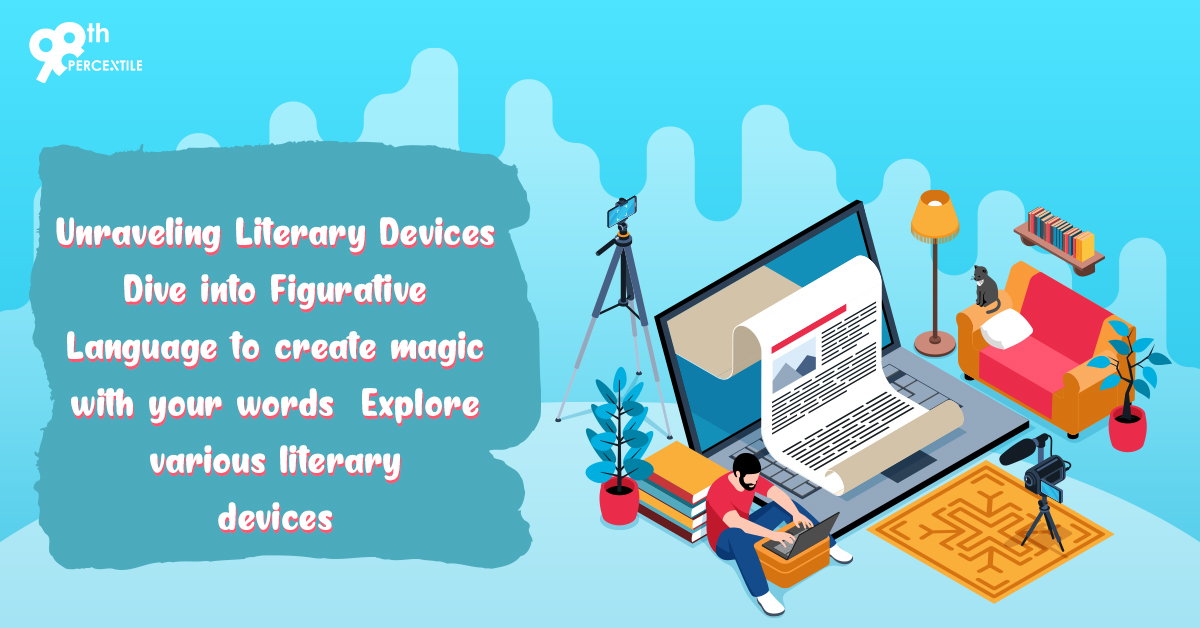What are literary devices?
The term "literary device" encompasses a wide range of techniques, styles, and strategies employed by authors to enhance their writing. Literary devices can encompass both overarching elements that consistently appear throughout a work of literature and specific, precise uses of words that occur only once. Essentially, a literary device refers to anything that can transform dull or bland writing into rich and engaging prose!
Improve Grammar & Vocabulary – Download FREE Now!
Literary Devices vs. Literary Elements vs. Literary Techniques: There is some confusion regarding these terms. To clarify:
Literary elements are broad literary devices that pervade an entire work, such as setting, theme, mood, and allegory.
Literary techniques refer to the specific literary devices that deal with individual words and sentences, such as euphemisms and alliteration.
How to Use Literary Devices in Your Writing: To incorporate literary devices into their own writing, writers must first recognize them "in the wild." Reading a list of these devices helps writers understand what they're looking for, and paying close attention while reading allows them to see how expert writers employ them. When ready to experiment with literary devices, the key is to use them naturally. Overusing literary devices can be distracting, so it's best to employ them sparingly and strategically, like a well-timed cymbal crash in music.
- Metaphor: Metaphors directly liken two dissimilar things, suggesting they share common attributes. For instance, in "The World is a Stage," the world is implied to possess qualities akin to a stage.
- Simile: Similes, like metaphors, draw comparisons between dissimilar entities, but they do so explicitly using words like "like" or "as." For example, "Her smile shone as brightly as the sun" employs a simile to clarify the brightness of the smile.
- Personification: Personification imparts human attributes or characteristics to non-human objects or entities. For instance, "The wind whispered through the trees" imbues the wind with the human-like ability to whisper.
- Hyperbole: Hyperbole involves deliberate exaggeration to emphasize a point, often to an extreme degree. For instance, "I've told you a million times" exaggerates the number of times something has been said to underscore its frequency.
- Onomatopoeia: Onomatopoeic words replicate or mimic the sounds they represent. For example, "buzz," "moo," or "crash" use onomatopoeia to echo the actual sounds.
- Alliteration: Alliteration entails the repetition of initial consonant sounds within a sequence of words. For example, "She sells seashells by the seashore" emphasizes the repeated "s" sound.
- Assonance: Assonance involves the repetition of vowel sounds within words. For instance, "The rain in Spain falls mainly in the plain" emphasizes the repeated "a" and "i" vowel sounds.
- Consonance: Consonance repeats consonant sounds within or at the end of words. For example, "pitter-patter" or "chuckle” features the repetition of consonant sounds for auditory effect.
- Oxymoron: An oxymoron pairs contradictory or opposing words to create a distinctive impact. For instance, "bittersweet" combines opposing tastes to convey a complex emotional experience.
- Allusion: Allusion refers to a reference to well-known persons, events, places, or literary works. For instance, saying "He had the wisdom of Solomon" alludes to the biblical figure Solomon to highlight wisdom.
- Irony: Irony encompasses contrasts between expectations and actual outcomes and can manifest in various forms, including verbal irony (saying one thing and meaning another), situational irony (a divergence from anticipated events), and dramatic irony (where the audience possesses knowledge not known to the characters).
- Symbolism: Symbolism employs objects, characters, or elements within a story to represent abstract concepts or ideas. For example, a dove symbolizes peace, while a red rose symbolizes love.
Here’s a list of some popular works:
Martin Luther King Jr.'s "I Have a Dream" Speech:
Metaphor: Dr. King envisions a future where the nation fully embodies its principles.
Simile: He expresses the relentless pursuit of justice and righteousness, comparing them to the unstoppable flow of water.
William Shakespeare's "Hamlet":
Metaphor: Shakespeare compares life to a stage, emphasizing the performative nature of human existence.
Personification: He personifies the morning, dressing it in a metaphorical garment as it walks over the hill.
Harper Lee's "To Kill a Mockingbird":
Symbolism: The mockingbird symbolizes innocence and the moral imperative to protect those who are blameless.
John F. Kennedy's Inaugural Address:
Antithesis: President Kennedy urges citizens to prioritize their contributions to their country over seeking benefits from it.
George Orwell's "Animal Farm":
Allegory: Orwell allegorically represents the Russian Revolution and the emergence of a totalitarian regime through the lens of farm animals.
Haruki Murakami's "Kafka on the Shore":
Surrealism: Murakami employs surreal and dreamlike elements to blur the boundaries between reality and the fantastical.
Bob Dylan's Song Lyrics:
Metaphor: Dylan poses a rhetorical question about the journey to manhood, using roads as a metaphor for life's challenges.
Simile: He likens a person's state to that of a rolling stone, suggesting a sense of aimlessness.
Bob Dylan's lyrics are celebrated for their poetic and figurative language, qualities that contributed to him receiving the Nobel Prize in Literature.
These examples showcase how figurative language is used by writers and speakers to convey complex ideas, emotions, and themes in memorable and impactful ways.
Figurative language in literature and teaching offers numerous advantages. It simplifies complex concepts, aids comprehension, and fosters engagement by employing metaphors, analogies, and similes. These tools make abstract ideas relatable and stimulate creative thinking, encouraging students to envision and analyze texts in unique ways. Emotional connections are forged through vivid descriptions and metaphors, deepening students' engagement with characters and narratives. Figurative language enhances memorability, facilitating long-term retention of information. Furthermore, it cultivates cultural and literary appreciation, enabling students to explore diverse literary traditions.
Book FREE English Trial Classes Now!

 Students/Staff
Students/Staff Parents
Parents ElevatEd
ElevatEd



-Nov-18-2025-03-57-47-3267-AM.png?width=360&length=360&name=401x226%20(6)-Nov-18-2025-03-57-47-3267-AM.png)



-Jul-22-2025-03-16-52-8797-AM.png?width=360&length=360&name=401x226%20(6)-Jul-22-2025-03-16-52-8797-AM.png)






